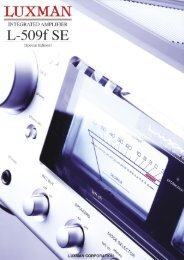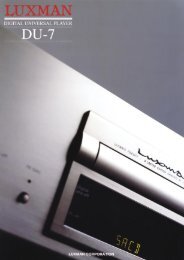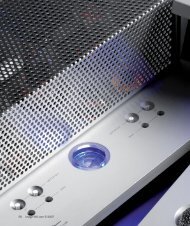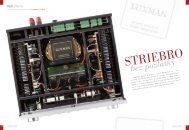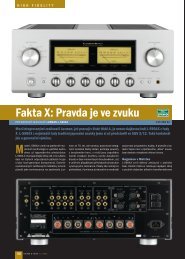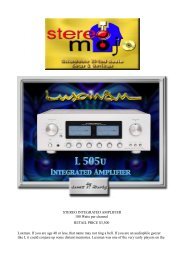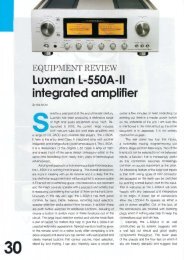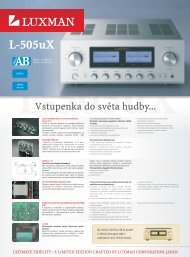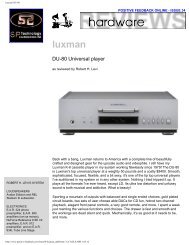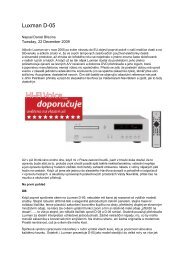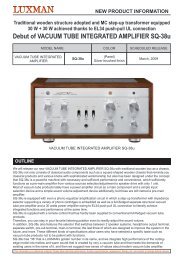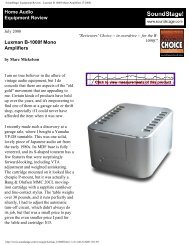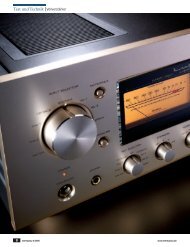Luxman L-509u test / SoundStage!
Luxman L-509u test / SoundStage!
Luxman L-509u test / SoundStage!
Create successful ePaper yourself
Turn your PDF publications into a flip-book with our unique Google optimized e-Paper software.
<strong>Luxman</strong> L-<strong>509u</strong> Integrated Amplifier<br />
by Uday Reddy<br />
"If I weren’t currently looking for a home in one of the most overpriced housing markets<br />
in the US, I’d be writing a check for the L-<strong>509u</strong>. Today."<br />
There’s a lot to be said for<br />
longevity in the business world. It<br />
speaks of a commitment to core<br />
principles and a focus on quality,<br />
with the needs of the consumer<br />
kept firmly in sight. When<br />
considering the past 20 or so years<br />
in the world of high-end audio,<br />
quite a few companies have<br />
withstood the <strong>test</strong> of time.<br />
However, thinking beyond that<br />
time period, the names get fewer:<br />
brands such as McIntosh, Audio<br />
Research and Klipsch. To those<br />
venerable names add <strong>Luxman</strong>,<br />
which has been around for more<br />
than 80 years. Few companies of<br />
any type have had that kind of<br />
staying power. Those that do<br />
usually know their target audience<br />
well and consistently produce topflight<br />
products. Known mostly for<br />
its excellent-sounding tube gear,<br />
<strong>Luxman</strong> also produces wellregarded<br />
solid-state electronics.<br />
Absent from North America for a<br />
number of years following a neardisastrous<br />
merger with Alpine<br />
Electronics, <strong>Luxman</strong> is now back<br />
on American shores with a full<br />
product line of sources, preamps<br />
and amplifiers.<br />
To that mix, <strong>Luxman</strong> has added<br />
the L-<strong>509u</strong> solid-state integrated<br />
amplifier ($10,000 USD). The L-<br />
<strong>509u</strong> is <strong>Luxman</strong>’s answer to the<br />
compromise-is-not-an-option<br />
approach to the integrated<br />
amplifier, with careful attention<br />
paid to all components that would<br />
Review Summary<br />
Sound<br />
Features<br />
Use<br />
Value<br />
"The L-<strong>509u</strong> was one dead-quiet integrated amp with an<br />
ultra-low noise floor, resulting in the blackest of<br />
backgrounds from which the music would emerge in solid,<br />
focused, three-dimensional images. Additionally, the L-<br />
<strong>509u</strong> was tonally neutral, and did not favor one end of the<br />
frequency spectrum over another; instead its sonic<br />
signature was geared toward delivering the least-colored,<br />
most musically natural performance, regardless of the<br />
type of music." "What impressed me most, however, was<br />
the L-<strong>509u</strong>’s control of the bass." "Subterranean? Without<br />
a doubt."<br />
"Power output is 120 watts into 8 ohms, reportedly<br />
doubling to 240 watts into a 4-ohm load.... Frequency<br />
response is 20Hz-20kHz for phono (yes, the L-<strong>509u</strong> has a<br />
phono stage, which I wasn't able to <strong>test</strong>) and 20Hz-<br />
100kHz for line-level sources." "One feature of the L-<strong>509u</strong><br />
is the high-quality electronic input selector switch, taken<br />
from <strong>Luxman</strong>’s top-of-the-line C-1000f preamplifier. This<br />
results in minimal sound-quality deterioration while<br />
increasing channel separation and crosstalk. The L-<strong>509u</strong><br />
also employs the solid-brass volume control used in the<br />
CL-88 vacuum-tube preamplifier."<br />
"Although <strong>Luxman</strong> offers remote controls for other<br />
products, no remote is supplied for the L-<strong>509u</strong>, owing to<br />
<strong>Luxman</strong>’s insistence on a design with no sonic<br />
compromise."<br />
"The L-<strong>509u</strong>'s true competition is the even more<br />
expensive Esoteric A-100 and other cost-no-object<br />
integrated amps. It’s just that good."
have an effect on sound quality. Made with premium parts to the exacting standards seen in <strong>Luxman</strong>’s<br />
entire product line, the L-<strong>509u</strong> fairly bristles with intelligent details and incorporates some of the best<br />
features found in <strong>Luxman</strong>’s preamps and amps.<br />
Full featured<br />
One feature of the L-<strong>509u</strong> is the high-quality electronic input selector switch, taken from <strong>Luxman</strong>’s topof-the-line<br />
C-1000f preamplifier. This results in minimal sound-quality deterioration while increasing<br />
channel separation and crosstalk. The L-<strong>509u</strong> also employs the solid-brass volume control used in the<br />
CL-88 vacuum-tube preamplifier. Additionally, noise and distortion have been kept to a minimum with<br />
the introduction of <strong>Luxman</strong>’s Only Distortion Negative Feedback (ODNF) version 2.2. ODNF is a<br />
circuit that separates and cancels distorted elements, thereby reducing noise and distortion, again<br />
resulting in purer sound.<br />
Very handsome in a retro style reminiscent of integrated amps from the '60s and '70s, the L-<strong>509u</strong>'s front<br />
panel is dominated by two large VU meters, backlit in baby blue. The front, top, bottom and side panels<br />
are made of machined, brushed aluminum, and the top panel is flanked on both sides by black-colored<br />
cooling vents. The L-<strong>509u</strong> measures 18 3/8"W x 7"H x 17"D and weighs 63 pounds. Power output is<br />
120 watts into 8 ohms, reportedly doubling to 240 watts into a 4-ohm load. Total harmonic distortion is<br />
rated at a very low 0.003%. Frequency response is 20Hz-20kHz for phono (yes, the L-<strong>509u</strong> has a phono<br />
stage, which I wasn't able to <strong>test</strong>) and 20Hz-100kHz for line-level sources.
The front panel has two large knobs on either side of the VU meters. The right knob adjusts the volume,<br />
while the left knob selects among four RCA inputs, two balanced line-level inputs and the phono input,<br />
which accommodates moving-magnet or moving-coil cartridges. Adjacent to the input selector are two<br />
small buttons; the upper button is for the tape loop, and the lower button selects the moving-coil stage<br />
for the phono input. From left to right, in a row along the lower section of the front panel, are the power<br />
button, a headphone jack, the record-output selector and a speaker switch for muting (especially helpful<br />
when swapping interconnects and cables) or switching between primary and secondary speakers.<br />
Continuing further, there’s a switch for selecting stereo or mono, and adjustments for bass, treble and<br />
balance. The L-<strong>509u</strong> is unusual in offering tone controls. These used to be standard on preamps and<br />
integrated amps, but lately have been left off many leading designs. Poorly designed tone controls may<br />
have gotten a bad rap, but, properly implemented, they can be quite helpful in taming edgy treble or<br />
muddy bass on poorly engineered recordings.<br />
Also on the front panel are three small buttons in a row below the volume control. The first button, Line<br />
Straight, is for those who are not interested in the tone controls, allowing their removal from the signal<br />
path. The second button, Separate, splits the preamp from the amp, allowing the addition of a roomcorrection<br />
device or a CD player with a digital volume control. The final button switches off the meters'<br />
lighting.<br />
The rear panel has a signal ground and an RCA input for a turntable. There are four more RCA inputs<br />
for various line-level sources along with two more RCA sets of jacks for the tape monitor. Below the<br />
RCA jacks are two sets of balanced inputs, both of which come with an ingenious feature. As there are<br />
regional differences throughout the world as to pin configuration for both sources and amplification,<br />
there is a button between each set of inputs that allows you to invert phase. The speaker binding posts<br />
are much like the binding posts that I encountered with the Esoteric A-100 integrated amp, which I<br />
reviewed last year. There are two pairs of vertically arrayed, gold-plated, plastic-shrouded posts that<br />
accept bare wire, spade lugs and banana plugs. These grasped the spades of my speaker cables tightly<br />
and can be manually tightened, no post wrench needed. Rounding out the rear panel is an AC socket for<br />
the detachable power cord and the line-phase sensor in the upper right corner. This last feature is clever.<br />
Press the button when first setting up the L-<strong>509u</strong> and the unit will check the phase of the electricity it is<br />
receiving. If the AC outlet is wired incorrectly, meaning the live and neutral wires are swapped, a red<br />
LED will warn you.<br />
Although <strong>Luxman</strong> offers remote controls for other products, no remote is supplied for the L-<strong>509u</strong>,<br />
owing to <strong>Luxman</strong>’s insistence on a design with no sonic compromise. For me, this was rarely an issue,<br />
as I would adjust the volume control at the beginning of an album and leave it at that setting. In fact, the<br />
only time that this was even an issue was when listening to the eclectic compilation CDs provided by
<strong>Luxman</strong>’s importer, Philip O’Hanlon of On a Higher Note. Because the tracks were from different<br />
artists and albums, recorded at different levels, I had to compensate with some tracks and adjust the<br />
volume. No big deal.<br />
The unit that had been sent to me by O’Hanlon had significant use prior to my evaluation; therefore, no<br />
burn-in was required and it performed flawlessly with no hiccups. Most of my evaluation was done<br />
using the L-<strong>509u</strong> with the tone controls defeated. I did also, on occasion, take advantage of the line-in<br />
option to drive the amplifier section using my Wadia 830 CD player’s digital volume control (and<br />
remote control!). Although the unit never got more than warm, even with extended use at high SPLs, I<br />
would still recommend having sufficient airspace over the top to provide adequate ventilation.<br />
Sound<br />
Like the Esoteric A-100 I reviewed, the L-<strong>509u</strong> was one dead-quiet integrated amp with an ultra-low<br />
noise floor, resulting in the blackest of backgrounds from which the music would emerge in solid,<br />
focused, three-dimensional images. Additionally, the L-<strong>509u</strong> was tonally neutral, and did not favor one<br />
end of the frequency spectrum over another; instead its sonic signature was geared toward delivering the<br />
least-colored, most musically natural performance, regardless of the type of music. Although a class-AB<br />
integrated amp, the L-<strong>509u</strong> likely runs in class A more than most integrateds at similar power outputs<br />
and volumes, resulting in this natural, distortion-free quality. The music was so natural-sounding and<br />
involving that I found myself listening more to the music than to the usual recorded artifacts that I often<br />
pay attention to when evaluating a component. Its ability to make me forget about what I was doing and<br />
just enjoy the music did wonders for increasing sheer musical pleasure, but at the expense of interfering<br />
with my ability to focus on and get down to the job at hand: reviewing the thing!<br />
Associated Equipment<br />
Loudspeakers – Wilson Audio Sophia.<br />
Integrated amplifier – Jeff Rowland Design<br />
Concentra.<br />
Digital – Wadia 830 CD player, Logitech<br />
Transporter wireless DAC, Apple MacBook<br />
with 1TB Apple Time Capsule.<br />
Interconnects – Transparent Audio Ultra<br />
MusicLink.<br />
Speaker cables – Transparent Audio Ultra<br />
MusicLink.<br />
Headphones and Headphone amplifier –<br />
Sennheiser HD 600 headphones, Ultimate<br />
Ears UE 11 Pro in-ear monitors, Ray<br />
Samuels Audio Emmeline, The Predator<br />
headphone amp.<br />
Accessories – Audio Power Industries<br />
Power Pack II.<br />
Dynamically, the L-<strong>509u</strong> was a solid performer, capable<br />
of wide swings in volume with no compression or<br />
congestion at louder volumes. A favorite classical<br />
recording of mine is of Seiji Ozawa conducting the<br />
Boston Symphony Orchestra’s performance of<br />
Stravinsky’s Petrouchka (BMG Classics 09026-63311-2).<br />
This rhythmic, fanfare-like composition is a great workout<br />
for integrated amps and can lack coherence when rendered<br />
through lesser components. The L-<strong>509u</strong> handled this<br />
composition with aplomb and without any sense of strain,<br />
and the transient response, particularly with strings and<br />
brass, was fast. With regard to soundstaging, most<br />
amplifiers perform best at realistic volumes, with the<br />
soundfield collapsing at lower volumes. However, the L-<br />
<strong>509u</strong> delivered soundstaging that was stable, broad and<br />
deep, even at low-level SPLs, and blossomed even further<br />
when the speakers were given more juice.<br />
Very impressive was the reproduction of high frequencies<br />
and the midrange. On "Azalea" from trumpeter Brian<br />
Lynch’s album 24/7 (Nigel Hayer 2055), Lynch solos on<br />
his trumpet with the band playing softly behind him, and<br />
little details, such as the crisp high hat or the faint brushes<br />
on the snare heard in the background, sounded light and<br />
delicate, while still remaining detailed. Lynch’s playing in the upper register was smooth, airy, and<br />
graceful, floating front and center, with no evidence of hardness or edge. The low noise floor of the L-<br />
<strong>509u</strong> again contributed to unveiling this low-level detail.
What impressed me most, however, was the L-<strong>509u</strong>’s control of the bass. Too often, excellent bass<br />
reproduction is attributed solely to the loudspeaker, but the partnering amplifier can have a significant<br />
contribution to the bass through its damping factor (in technical terms, the ratio of the impedance of the<br />
source to that of the loudspeaker), thereby reducing undesirable movement of the woofer near its<br />
resonant frequency. This integrated amp exerts such muscular control over the woofer that the lower<br />
frequencies, particularly the deepest octaves, were rendered with power and control. Being nearly full<br />
range, my Wilson Audio Sophia speakers have ample bass output, and I was quite confident that over<br />
the past four years of ownership, I had experienced their full capabilities. However, listening to "Dead<br />
Already" from the American Beauty soundtrack (DreamWorks 450233) was a revelation. This track<br />
starts off with what sounds to my ears like a marimba, with more percussion and guitar added as the<br />
track progresses. Suddenly, both bass drums and gut-wrenching bass guitar or synthesizer kick in<br />
forcefully, with impact that I wasn’t prepared for. Although the lowest frequencies rolled off slightly,<br />
the depth of bass achieved was startling, with substantial weight and a sustained, room-filling pulse of a<br />
quality that I had never heard before with these speakers. Subterranean? Without a doubt. This<br />
characteristic was intoxicating and addictive.<br />
After hearing this incredible bass response, I dove deep into my collection of rock recordings to exploit<br />
and enjoy this quality. The Rolling Stones, the Who, Led Zeppelin? Check. The Grateful Dead, the<br />
Allman Brothers Band, Little Feat? Double check. The bass flat out rocked, and I just couldn’t get<br />
enough. Even so, it wasn’t just deep bass that impressed but also the ability to follow individual bass<br />
lines. On "Cause We’ve Ended As Lovers" from Jeff Beck’s Live At Ronnie Scott’s (Eagle Records ER<br />
20150-2), young bass phenom Tal Wilkenfeld plays sensitively behind Beck as he solos in the beginning<br />
of the piece, yet each note can be heard distinctly. As the piece progresses and segues into Wilkenfeld’s<br />
solo, her bass comes to the forefront, every pluck and inflection conveyed perfectly. On more up-tempo<br />
cuts, like "Beck’s Bolero" and "Led Boots," Wilkenfeld’s bass lines merge more with the rhythm section<br />
but continue to provide a solid foundation to the bottom end.<br />
I don’t spin vinyl, so I didn’t have a chance to evaluate the phono section and can’t comment on its<br />
performance. I did, however, spend time listening to headphones via the L-<strong>509u</strong>'s headphone output.<br />
This is no thrown-in feature. The L-<strong>509u</strong> was able to drive both my Sennheiser HD 600 headphones and<br />
Ultimate Ears UE 11 Pro in-ear monitors effortlessly, coming in handy for early-morning and late-night<br />
listening sessions while my family was sleeping. This feature is significant. It eliminates the need for a<br />
dedicated headphone amp.<br />
Face off<br />
The most striking difference between the L-<strong>509u</strong> and my Jeff Rowland Concentra ($5600 when still<br />
available) was with the bass reproduction. Tonally, they are quite similar -- uncolored and musically<br />
natural -- but with regard to the control of the woofer and the ultimate low-frequency extension, the<br />
Concentra was no match. My current room is compromised in the bass department because of it small<br />
volume, so I still experience some bass overhang with the Concentra, especially at louder volumes. The<br />
extraordinary control of the L-<strong>509u</strong> made it seem as if I had a subwoofer in my system, and yet the<br />
problems with overhang were largely eliminated.<br />
The treble and midrange were very comparable between the two integrateds. However, the lower noise<br />
floor of the L-<strong>509u</strong> allowed more detail to emerge within these frequency ranges, particularly in quiet<br />
interludes that otherwise would have been somewhat veiled with the Concentra. Dynamically, the L-<br />
<strong>509u</strong> brings more power to the table, enabling it to offer much better transient response that’s especially<br />
noticeable with symphonic music.<br />
The L-<strong>509u</strong>'s true competition is the even more expensive Esoteric A-100 and other cost-no-object<br />
integrated amps. It’s just that good.
Conclusion<br />
The <strong>Luxman</strong> L-<strong>509u</strong> is a versatile, full-featured integrated amplifier, complete with a MM/MC phono<br />
section and a headphone output, and it offers sonic performance that easily outclasses my current<br />
reference. It may cost almost twice as much, but, to me, its features and performance easily justify the<br />
added expense.<br />
If I weren’t currently looking for a home in one of the most overpriced housing markets in the US, I’d<br />
be writing a check for the L-<strong>509u</strong>. Today.<br />
...Uday Reddy<br />
uday@soundstage.com



